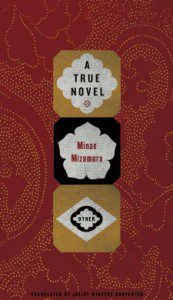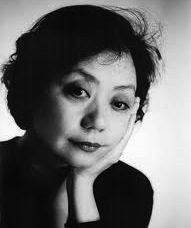
In a letter from 1796, Wilhelm von Humboldt, the founder of the University of Berlin, wrote that “All translation seems to me simply an attempt to solve an impossible task. Every translator is doomed to be done in by one of two stumbling blocks: he will either stay too close to the original, at the cost of taste and the language of his nation, or he will adhere too closely to the characteristics peculiar to his nation, at the cost of the original. The medium between the two is not only difficult, but downright impossible.” Based on Mr. Humboldt’s criteria, then, A True Novel by Minae Mizumura has a lot of reasons to fail.
A True Novel is not just a translation in the literal, linguistic sense. It’s a reworking of Emily Brontë’s Wuthering Heights set in mid-20th century Japan and America, which in itself is a massive accomplishment of translation. Wuthering Heights, the estate, is morphed into the summer homes of the wealthy elite in Japan. The book’s Heathcliff, Taro Azuma, comes from post-war Manchuria instead of being an adopted gypsy child. Even the book’s prologue echoes eerily with the preface Charlotte Brontë added to Wuthering Heights after Emily’s death. In it, Charlotte writes that the “immature but very real powers revealed in ‘Wuthering Heights’ were scarcely recognized” and laments the general lack of reception she and her sisters received early in their careers. Mizumura-as-narrator echoes the same concern in her opening to A True Novel, in which she describes “the strong desire to hear a resounding voice from on high telling one that one was indeed destined to write.”
Don’t assume that being inspired by Wuthering Heights limits Mizumura’s work in any way. Mizumura’s greatest act of translation sorcery is to drag Wuthering Heights’ basic plotline into the modern, or to be more accurate, postmodern literature scene. Just as Wuthering Heights is framed by the housekeeper telling the story to the narrator, A True Novel is built layer by layer and then slowly peeled back in the process of Mizumura’s storytelling, echoing other iconic postmodern texts—I was frequently reminded of Fowles’ The French Lieutenant’s Woman. While not every layer holds up against the others in terms of how much they seem to benefit the story, the style forces the reader to interrogate the purpose of each piece of information, not just to the narrative, but to the character relating that narrative. Slowly, piece by chronologically-out-of-place piece, a picture emerges of a wealthy Japanese family straddling the past, which gives them their status, and the future of post-World War II Japan. Taro bursts into their lives and holds every character’s attention, but the family has its own share of vibrant personalities, especially Natsue, Harue, and Fuyue. Each of these three sisters, named after the seasons, has her own reaction to Taro and the events of the novel. They’re an imposing and intimidating trio, terrifying to characters and readers alike but also full of mystique; their scenes are filled with pulse-quickening excitement, especially when the three are together. Fumiko, though, is the one who steals the stage. Sometimes narrator, sometimes object of narration, Fumiko is the housekeeper who moves far beyond the near-forgettable Nelly Dean of Wuthering Heights. Fumiko’s arc surprises us, right up to the very last page.

Mizumura herself is a character within the novel, and there’s never any indication as to how much of her character is based on her real life. (You can find out more from the interviews on her site, but I’d recommend saving them until after you finish the book.) As we follow her story and enter the world of A True Novel, we’re left to wonder who is going to “play” the memorable cast of Wuthering Heights. I found myself convinced that one character was going to be Catherine, only to have my mind changed twice fifty pages later.
I reread Wuthering Heights shortly before A True Novel. Brontë’s work absolutely adds an additional level of engagement with the text. Rereading Heights was not a completely positive experience—I found myself put off by the lack of sympathetic characters. But that lack seems to allow Brontë to create these incredibly potent scenes between characters, scenes that pulse with torrents of emotion. Mizumura chooses a different route: we sympathize with several of her characters, but they remain just out of our reach, unknowable due to the limited and unreliable layers of narration. This keeps the emotional flare-ups believable and just as evocative as the collisions between Brontë’s characters. Early on, we see a description of Taro dancing: “All I knew was that my body was in his arms, being whirled around the floor at a frightening speed. His own body was tight with pent-up emotion; it felt almost as if he was punishing me.” Like Wuthering Heights, the reserved, formal world around the characters serves to enhance every character’s outburst. Mizumura uses this to her full advantage, creating masterful depictions of love in myriad forms and combinations. A True Novel challenges what we know about relationships and happiness, blurring the lines between romance and obsession, between tolerance and resignation.
The book is an intimidating 854 pages but is worth every word, and it’s distributed between two volumes in the same style as its original Japanese counterpart. Interspersed throughout the text are black and white photographs depicting the Japanese scenery of the novel. A True Novel’s English translation was brought to America by the now defunct Japanese Literature Publishing Project (JLPP), a Japanese government-backed venture to encourage the translation of Japanese literature. The project was cancelled in 2012 (although works in progress like A True Novel are continuing until completed) on the theory that private industry should be responsible for such endeavors, which is a depressing thought. The book won Mizumura the prestigious Yomiuri Prize at the time of its original publication in 2002, and Mizumura has taught at several universities in the United States, but the translation to English took eleven years and government funds, which have already been defunded. It’s heartbreaking to think that the next work equal to A True Novel might not make it to America. In an interview, Mizumura says she didn’t expect the novel to be translated at all, which is surprising since this book is practically made for translation—with its foreign source of inspiration, the omnipresent influence of America in the postwar-Japan setting, the photographic aids, and the other types of translation that went into its creation. A True Novel is a masterpiece that breaks down all kinds of barriers, one that deserves to transcend the borders between languages and nations as well.




